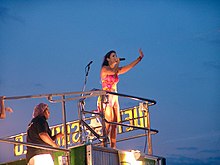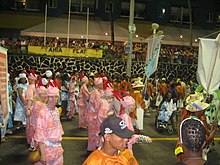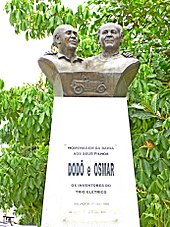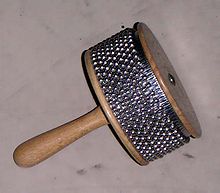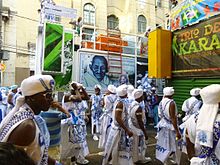Carnival in Salvador
The Carnival in Salvador da Bahia ( Portuguese Carnaval da Bahia ) is the largest street carnival in the world and one of the largest celebrations on earth , according to the Guinness Book of Records . Up to 2.7 million people take part in the celebrations in the capital of the Brazilian state of Bahia . The carnival takes place in three main locations (circuito): Dodô (in Barra-Ondina), Osmar (on the Campo Grande of Avenida Sete) and Batatinha (in the Centro Histórico, the historic center of Salvador). Furthermore there are district festivals u. a. in Cajazeiras, Itapoã, Periperi and Pau da Lima. During the carnival, famous bands such as Olodum , Daniela Mercury , Timbalada and Ivete Sangalo play at open-air concerts and on the Trios Elétricos. The popularity and international fame of the Carnival in Salvador is very high next to that in Rio de Janeiro or Olinda . The largest carnival event takes place in Salvador, another well-known carnival festival of the state of Bahia is in Porto Seguro .
history
The Bahia Carnival dates back to 1884. An event organized by dance salons and private clubs became the street carnival for the people. In 1890 the first Afoxé block took part in the carnival and celebrated costumes and customs from the culture of the Yoruba , the descendants of many former slaves .
- 1950 first Trio Elétrico with the Vassourinha-Block, a Frevo dance group from Pernambuco
- 1961 first parade in honor of Rei Momo
- 1962 Bloco Os Internacionais as the first carnival block
- 1969 Caetano Veloso sings the song: "Atrás do Trio Elétrico Só Não Vai Quem Já Morreu" (Only those who are already dead do not go after the Trio Elétrico)
- 1970 Salvador Carnival takes place in Praça Castro Alves, the era of cultural, social and sexual liberation begins
- 1972 Tribute by the Trio Tapajos to Caetano Veloso, who was arrested by the Brazilian military government
- 1974 Dodô and Osmar celebrate the silver jubilee of the Salvador Carnival
- 1976 in Bahia established Trio Tapajós gives impetus to the carnival events in Belo Horizonte and Santos from
- 1978 year of death of Adolfo Nascimento (Dodô)
- 1980 the Trio Elétrico "Traz Os Montes" revolutionized the Carnival of Salvador with a new kind of sound technology
- 1998 Inauguration of a monument in honor of the carnival founders Dodô and Osmar
Inventions
Pau Elétrico
The Pau Elétrico or Bahian guitar, which originated in the 1940s, enabled the development of the street carnival on large floats, the so-called Trio Elétricos. The Pau Elétrico was inspired by a type of electric guitar designed by Benedito Chavez in Rio de Janeiro .
"They bought a cavaquinho and a guitar, of which they broke off the cavity so that only the arm remained and attached a body made of jacaranda wood and a receiver to it," reports the guitarist Armandinho, son of Osmar and the only survivor of the oldest trio Elétrico Armandinho, Dodô and Osmar. “Until they realized this invention, they were using soft fat,” he says. This is how the Pau Elétrico, the first electric instrument in the Brazilian Carnival, came about. "
Other typical instruments are the violão-pau-elétrico with bass tones and the tenor guitar triolim.
Trio Elétrico
The Trios Elétricos are typical of the street carnival in Salvador. They originated from an old Ford Bigode, built in 1929, which was converted into the first Trio Elétrico and painted and decorated for the carnival celebrations. Musicians then played with the typical Pau Elétrico on the loading area. The Trio Elétrico was invented by Dodô (real name Antonio Adolfo Nascimento) and Osmar Macedo, who had worked together on the radio since 1938. Both were music students and were looking for a technical way to increase the volume of instruments without cables. In 1950 they succeeded in the first street carnaval in Salvador with the help of the Pau Elétrico and the Trio Elétrico. The first car was called Fobica. In 1951 they invited the musician Temístocles Aragão, and the “Trio elétrico” was born from the “Duo elétrico”. In the following year, the trio had to do without Temístocles Aragão, but despite the fame gained from the previous year, the name Trio remained Elétrico.
After the great success of the Trio Elétricos, larger trucks were later used to provide larger bands with a performance platform.
In 1969 the MPB singer Caetano Veloso became known nationally with his song " Atrás do trio-elétrico ". Trios Elétricos are semi-trailers with changing rooms, bars and a large stage in the modern carnival. They also have large music systems with an output of up to 100,000 watts. Today the Trios Elétricos are used by the various artists and bands who parade through the city and through the districts of Barra, Ondina and Campo Grande and which are followed by a large fan base. While the wagons are a kind of moving stage for artists, actors, dancers and celebrities, the people dance behind the Trio Elétricos or wait for them on the roadside.
Blocks (blocos)
Blocks (blocos) are units of carnival groups that appear under different affiliations, themes and music groups in the street carnival of Brazil. The carnival blocks are musical, aesthetic and religious manifestations. Indian origins are also expressed in the blocks. The motifs of the street carnival change every year and are political or social parodies and parodies. In 1997 the group Olodum, which has over 3,000 followers, sang in their samba-reggae song "Mundo Cão" (Dog or Devil's World) the difficult and discriminatory living conditions of the black population of Salvador, which is also known as "Roma Negra" black Rome, is called.
As a rule, the members of a block wear the same costume or at least the same shirt (abadá). The abadá is a mostly white piece of clothing worn by African Muslims. In Bahia, abadás are mainly worn by capoeira dancers . In the Brazilian carnival, the abadá symbolizes belonging to a block or a Camarote in different colors, patterns and logos and must be purchased. You can only take part in a move of a block within the rope boundary or in a moving or fixed Camarote by purchasing an Abadá. Camarotes are a type of carnival associations that perform together in blocks and trios elétricos. Behind most of the Trios Elétricos, a similarly sized car drives behind with spectators. Camarotes can therefore be mobile or fixed as a grandstand on the roadside.
The origins of the carnival blocks or "cordões" (ropes) go back to 1889. The Cordões were feared by the decent citizens because of the participating capoeiristas, the "dance fighters". From 1920 the influence of the intellectuals prevailed, who recognized a kind of cultural testimony in the carnival and therefore put an end to the "mess" that had existed until then and brought the form of organization into being that is still known today.
In 2013, the Salvador Carnival performed a total of 38 blocks. One “animator” is assigned to each block. These are usually well-known singers like Ivete Sangalo with the Coruja (owl) block or Léo Santana with the Muquiranas gay block.
Afro blocks
The Afro-Blocks are the most famous carnival groups of the Carnival in Salvador, which go back to their ethnic origin in West Africa. The oldest and most traditional carnival block is Ilê Aiyê and consists of around 3,000 members and numerous guests. Others include Filhos de Gandhy , A Mulherada, Afro Liberdade, Big Bloco do Gueto, Bloco da Capoeira, Ginga do Negro. In Afro blocks, the so-called Puxadas do Ijexá serve the honor of the Afro-Brazilian Orixais deities.
Afoxé
The carnival in Salvador and in the entire state of Bahia has its roots in the Indo-Euro-Afro-Brazilian understanding, but above all the African religion Candomblé . That is why the Afoxé is also known as the “street candomblé” in Brazil. Its importance is expressed in music and numerous costumes. The word “Afoxé” comes from the Yoruba language and consists of three words: a (nominal prefix) - fo (to say) - xé (to realize). One could paraphrase it with the words “what is said becomes action” or “what is said becomes reality”. In an Afoxé block there are mainly instruments such as drums, Afoxés and agogos. The chant is sung by one to the front and then after the entire block, similar to what happens in the houses of Candomblé.
Filhos de Gandhy
A large block of the Afoxé are the Filhos de Gandhy , "Sons of Gandhi", who identify with the ideals of Mahatma Gandhi , especially peace. At the carnival, this block stands out with its blue and white appearance from thousands of members wearing white turbans.
The Filhos de Gandhy were founded in 1949 under the direction of Durval Marques da Silva from warehouse workers (estivadores) of the port of Salvador, an elite of black workers, especially since this form of port work was relatively independent. In order to avoid reprisals from the military dictatorship at that time, the fear was too great of having to suffer reprisals from the namesake of the Gandhi bloc who had been murdered the previous year and who had triggered a peaceful revolution with his hunger strike in 1932, its founders changed the name "Gandhi" to "Gandhy" . From a block of 36 participants, the club, which today has more than 17,000 supporters, is based on Pelourinho in the historic center of Salvador. Even if the association's requirement to refrain from alcohol is not taken very seriously, the large block is reminiscent of a great peace movement, probably Mahatma Gandhi's greatest goal.
Muquiranas
In 1964, the appearance of the Salvador Carnival changed radically when men in women's clothes mingled with the celebrants for the first time. Lindolfo Araújo, nicknamed Charita, and a few friends were the leaders of this little revolution. The costumes were made with the help of his wife, mother and cousins. In the meantime, family fun has turned into a lucrative business in the third generation and the Muquiranas, the " sluts ", with thousands of fans of the block, have become an indispensable part of Salvador's carnival for a year as Barbies, then as geishas or Aphrodite . The participants are not only gays, but also married family fathers, for whom up to 200 € for the costumes is not a shame. While the Muquiranas celebrated in 2013 as the Greek goddess of love through the Osmar carnival area, armed with a water pistol, they were animated by the singers Léo Santana (Parangolé) and Alex Max (Saiddy Bamba) on the Trio Elétrico. On their official website, the Muquiranas announced on February 18, 2013 that Florisa Paganelli de Carvalho, wife of Lindolfo Araújo and co-founder of the Muquiranas Block, died on that day at the age of 77.
Axé
The axé is a typical musical rhythm in Bahia and is understood as a fusion of the frevo and the afoxé. Well-known Axé groups and artists from the Salvador da Bahia region are, for example, Luiz Caldas , Sara Jane, Chiclete com Banana , Banda Beijo , Banda Cheiro de Amor , Babado Novo , Bandamel , Ara Ketu , Banda Eva , As Meninas , Rapazolla , Terra Samba and Olodum . Olodum and her powerful percussion group transformed the Carnival of Salvador into the largest, longest and loudest open air event in the world. Typical of the street carnival are the "baterias", drum and percussion groups that march through the streets of the old town in large processions. The street carnival and the numerous live events increasingly turned into a talent competition for young artists, who are supported by successful musicians such as Luis Caldas, Chiclete com Banana, Ilê-Ayê, Margareth Menezes and Olodum. The latter keep the balance between commercial music and tradition.
Daniela Mercury
Between 1992 and 1993 Daniela Mercury became one of the best-known figureheads of the Carnival in Salvador with her samba-reggae hit "O Canto da Cidade" (The Song of the City). It became known worldwide. The Brazilian TV channel Rede Globo helped Daniela Mercury to her success.
tourism
The carnival season brings Salvador and the surrounding area a sharp increase in overnight stays and income every year. In 2006, around half a million domestic and foreign tourists came to Salvador to celebrate the carnival there. This represents an increase of 30% compared to visitors who visit Salvador and Bahia during the summer months. The motto of the carnival is: " Bahia: major explosão de alegria " (Bahia: the greatest explosion of joy). Salvador is being transformed into a “cidade de carnaval” (carnival city) on an area of 25 square kilometers and offers first aid stations and police standby for the safety of visitors . Carnival becomes the city's largest employer. 200,000 people are directly connected to the carnival activities. 86,000 of them are so-called "Cordeiros", which have the task of securing the blocks with a strong rope.
organization
2011 program
During the carnival in Salvador da Bahia in 2011, the following was on the program: The carnival events began simultaneously on Espaço do Samba e das Orquestras (Praça Municipal), Largo do Pelourinho, Praça Tereza Batista, Largo Pedro Archanjo, Largo Quincas Berro d'Água and Palco do rock (Piatã). The main event took place in the districts of Campo Grande (Circuito Osmar), Barra Ondina (Circuito Dodô) and in the Centro Histórico (Circuito Batatinha). The festivities began on Thursday, March 3, 2011, with the solemn and symbolic handover of the city's keys to the Rei Momo , the Brazilian King of Carnival, by the mayor and ended on Ash Wednesday night on March 8, 2011. An Music groups of different styles from Axé to Pagode, such as Banda a Mulherada, Fundo de Quintal, É o Tchan, Grupo Revelação, Soweto, Samba de Saia, Pixote, Banda da Saudade, Harmonia do Samba , Chicabana, Ilê Aiyê, performed in various places in the city . Cláudia Leitte and Babado Novo, Banda Eva, Banda Cheiro de Amor, Banda Beijo, Araketu, Banda Os Negões, Chiclete com Banana, Timbalada, Ivete Sangalo, Netinho, Carlinhos Brown and many others, on stages or on the Trio Eletricos. Famous actresses, TV stars, celebrities, politicians and artists such as Carla Perez, Luciana Mel, Carlos Pitta etc. also presented themselves. The main carnival procession traditionally begins on Friday. On Saturday the Afro Bloco "Ilê Aiyê" moves into the famous Rua do Curuzu and on Sunday afternoon the Batuque des Blocos Filhos de Gandhy begins on the Pelourinho in the old town. On Ash Wednesday there will be a final concert for all groups on Praça Castro Alves. The end of the carnival in Brazil has the symbolic meaning of the end of summer. For fun, it is said that the Brazilian year only begins after Carnival. - On the weekend after the carnival, there are new carnival activities in the Barra district, in which the carnival bands are awarded prizes, and there is also the so-called "Baile de Ressaca" (hangover dance) in dance halls on the beach.
Carnival problems
Due to the heavy police presence, the carnival is quite peaceful. Nevertheless, the flow of people can always get tight. The private camarotes are protected from the crowds by security guards. At temperatures around 30 ° C and a humidity of 80%, non-stop dancing always leads to a state of exhaustion. Another danger is excessive alcohol consumption.
Some foreign authors describe the carnival in Salvador and the state of Bahia generally as " six days and nights of ecstasy " and " public mass copulation ". The origin of this prejudice is associated with the joy of life, attitude to sexuality and instinctuality of the Candomblé (especially in connection with the Orixais Xang and Exu). In the Candomblé religion, sexuality is seen as a positive and driving force.
This attitude towards sexuality has made Salvador a popular travel destination for sex tourists, especially during Carnival time. For some years now, the Brazilian state has been using all its might to combat sex tourism in its illegal forms at the endeavors of responsible politicians. In order to curb the risk of AIDS , condoms have been distributed to the population at stalls and by the Trios Elétricos for several years . Brazil has an exemplary anti-AIDS policy, so the number of new infections fell significantly.
Since 2010, bracelets have been distributed for children, if they should get lost in the crowd, they can be better identified. You regularly meet employees who are on the lookout for lost children in order to take them into their care or to hand them back to their responsible persons. The carnival, which is better and better prepared from year to year, offers tourists a colorful picture of Brazilian culture as well as a cultural event for Brazilians with which they can identify themselves and their history.
Review of Carnival 2013
The good preparation of the city administration paid off not only during the festival, but also afterwards. A heavy police presence and rigorous rules made the pleasure a relatively safe event. On February 13th, those responsible presented facts and figures. Accordingly, for safety reasons, 12,736 kebab skewers, 38 knives and over 2000 glass bottles with beer or other alcoholic beverages were confiscated. In addition, 98 charcoal grills and small fires were extinguished and destroyed. Drunk drivers were dealt with with the same harshness: 1688 drivers were stopped and subjected to an alcohol test; increased alcohol levels were found in 160. 1345 bars and snack bars were visited, of which 340 hygienic and other complaints such as missing price lists were registered.
It's hard to imagine, but the deafening noise of the Trios Elétricos also has limits: 7 vehicles were classified as too loud and had to reduce the volume accordingly. Unfortunately, there were still two murders, one by a knife and another by a shootout. 1085 carnivalists had to undergo treatment after a fight, 343 of them in the nose and mouth area. 226 people were saved from drowning. 7 lost children were brought back to their families or responsible persons. 845 arrests were recorded for drugs and theft, three times the previous year.
To keep the streets clean, 2,000 chemical toilets were installed; a number that is set to increase in the coming year. Ash Wednesday was over 1000 tons of trash removed from the streets. Most of the wood paneling on monuments and house entrances to protect against dirt and vandalism had been removed by the evening. Overall, the results were quite positive and the preparations were praised as sufficient, although many suggestions for improvement were made for the coming year.
Web links
- Chicabanda - Salvador Carnival 2011
- Street Carnival 2011 Salvador da Bahia, view from Camarote Ondina
Individual evidence u. Remarks
- ↑ a b c d e f g h i Carnival in Salvador on the Brazil portal .
- ↑ "Ambassador of Africa"
- ↑ Portuguese: Vassoura, vassourinha - broom, small broom
- ^ In German: Block der Internationale
- ↑ In German: Behind the mountains
- ↑ In German: Electric stick
- ↑ Article on Pau Elétrico ( Memento of June 8, 2011 in the Internet Archive ).
- ↑ Armandinho
- ↑ Thu pau de sebo ao baile elétrico: as origens do Carnaval de Salvador. In: UOL. February 7, 2013. Retrieved February 17, 2013 (Portuguese).
- ↑ In German: Electric bass guitar
- ^ Trio elétrico. In: Yahoo! Respostas. 2007, Retrieved February 17, 2013 (Portuguese).
- ↑ Bastidores da Folia. In: Portal Carnaval. Retrieved February 17, 2013 (Portuguese).
- ↑ Truck, illustration
- ↑ In German: The Trio Elétrico after
- ↑ a b c d e f g Michael Schwelien: Carnival, Sex and Death. In: Die Zeit , February 19, 2004 .
- ↑ Overview on www.abadaweb.com.br
- ↑ In German actually: box, cabin, ship's cabin
- ↑ Overview of blocos-Afro do carnaval da bahia Salvador ( Memento of the original from March 6, 2011 in the Internet Archive ) Info: The archive link has been inserted automatically and has not yet been checked. Please check the original and archive link according to the instructions and then remove this notice. .
- ↑ Note: Ijexá, an ethnic subgroup of the Yoruba
- ↑ afoxé 04. (No longer available online.) In: Cronicas da Bahia - Tasso Franco. Archived from the original on January 3, 2009 ; Retrieved February 16, 2012 (Portuguese). Info: The archive link was inserted automatically and has not yet been checked. Please check the original and archive link according to the instructions and then remove this notice.
- ↑ subject of the statement vs. Subject of the statement. In: Justo Fernandez Lopes - Lexicon of Linguistics. December 9, 2011, accessed February 16, 2012 .
- ^ História Gandhy. (PDF; 706 kB) In: Filhos de Gandhy. February 21, 2009, Retrieved February 12, 2012 (Portuguese).
- ↑ Filhos de Gandhy diamonds estrutura. (No longer available online.) In: Portal A Tarde. Archived from the original on April 7, 2014 ; Retrieved February 12, 2012 (Portuguese). Info: The archive link was inserted automatically and has not yet been checked. Please check the original and archive link according to the instructions and then remove this notice.
- ↑ As Muquiranas Salvador Carnival Blocos. In: About.com Travel Brazil. Retrieved February 18, 2013 .
- ↑ Bloco “As Muquiranas” inicia vendas de fantasias para o Carnaval 2013 ( Memento from March 6, 2013 in the web archive archive.today )
- ↑ As Muquiranas divulga [!] A fantasia do Carnaval 2013. (No longer available online.) In: Carnasite. January 30, 2013, archived from the original on April 7, 2014 ; Retrieved February 18, 2013 (Portuguese).
- ↑ As Muquiranas. In: As muquiranas. February 18, 2013, accessed February 18, 2013 (Portuguese).
- ↑ Note: typical Bahian music style with axé, samba and reggae elements
- ↑ Overview Carnevals Program Programação do Carnaval de Salvador 2011
- ↑ Note: Batuque or Batucada - Afro-Brazilian drum music
- ↑ Turismo Sexual: ameaça à cidadania ( Memento from December 31, 2012 in the web archive archive.today ), article on jornaldaimprensa.com.br (Portuguese).

